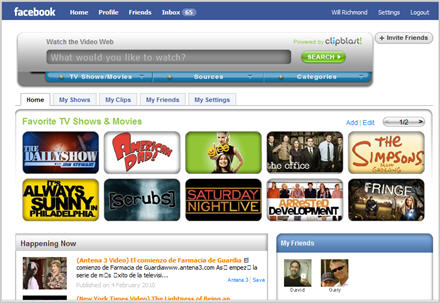-
comScore Data Shows 2009 Was a Blistering Year for Online Video (Slides Available)
Last Friday, comScore released its Dec. '09 data for online video usage. I've been tracking comScore's data for the last 3 years and Dec put an exclamation mark on what many of us already knew: 2009 was a blistering year of growth in online video consumption. Below are graphs of the most important data (Click here if you'd like a complimentary PDF download of all of the slides.)
The first graph shows total online video views more than doubled from 14.8 billion in Jan '09 to 33.2 billion in Dec '09. The historical growth is even more impressive. Just two years ago, in Dec '07, comScore reported 10 billion video views.
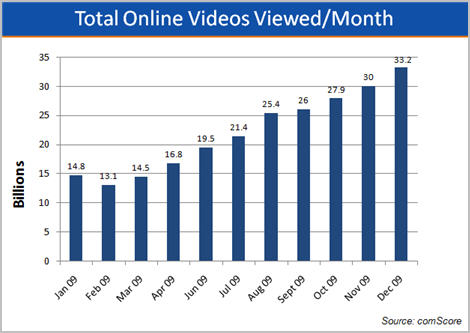
Online video usage is now nearly ubiquitous in the U.S. According to comScore, in Dec '09, 86.5% of all U.S. Internet users watched online video, up nearly 10 percentage points from the 76.8% in Jan '09. That translates to 178 million people watching video in Dec '09, up from 147 million in Jan '09. Back in Jan '07, there were 123 million viewers.
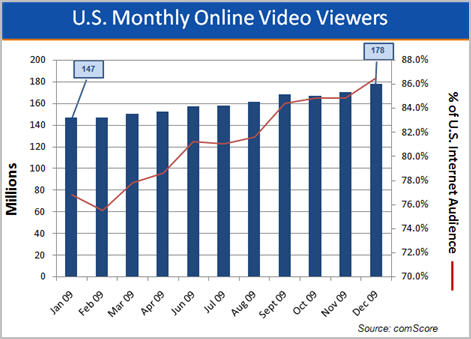
Those users are watching a whole lot more videos as well. For Dec '09, comScore reported that 187 videos were watched per average viewer, up 85% from 101 in Jan '09, and more than triple the 59 watched in Jan '07.
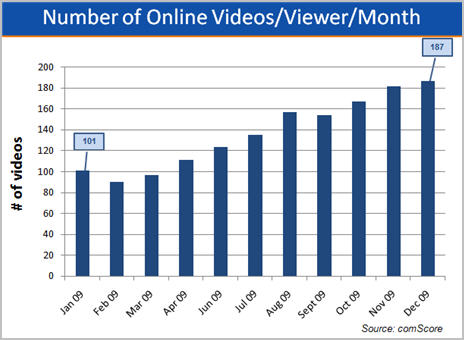
As well, those viewers spent a lot more time watching online video. In Dec '09 comScore said that the average online viewer watched 762.6 minutes or 12.7 hours, more than double the 356 minutes viewed on average in Jan '09. Here's the really incredible stat: back in Jan '07, comScore pegged this number at just 151 minutes or about 2 1/2 hours, meaning average viewing time has more than quintupled in the last 3 years.
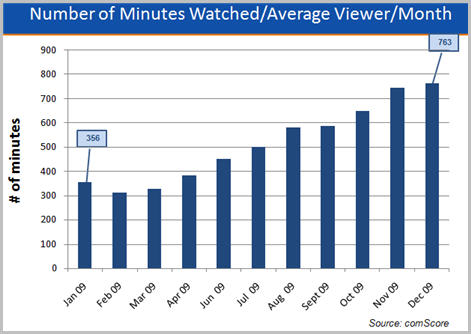
I've talked many times about how YouTube is the 800 pound gorilla of the online video market, and 2009 only further cemented this. Videos viewed at YouTube surged from 6.3 billion in Jan '09 to 13.2 billion in Dec '09. To put this in perspective, Google closed its acquisition in Nov '06. In Jan '07 (the first month comScore publicly released online video data), YouTube notched 1.2 billion views. That means that in the 3+ years that Google has owned YouTube, it has grown more than 10x in size. More amazing is that even with all the growth by other sites (particularly Hulu), YouTube has kept up its approximate 40% share of the overall online video market, starting the year at 42.9% and ending at 39.8%.
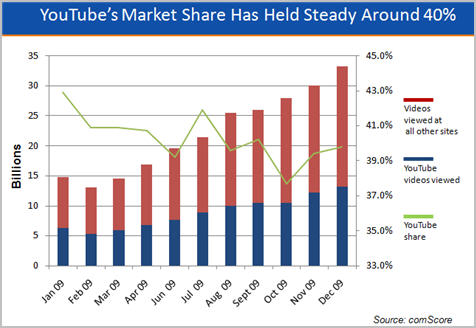
Speaking of Hulu, in its first full year of operation, the site surged from 250 million views in Jan '09 to 1,013 billion views in Dec '09. Unique viewers increased from 24.4 million in Jan '09 to 44.1 million in Dec '09. But if you look at the red line in the graph below, you'll see that uniques jumped to 41.6 million by Mar '09 which I believe must be due, at least in part, to a likely measurement change by comScore. Since Mar you'll notice that uniques hovered right around 40 million each month, dipping below during the summer and then bouncing back in Q4.
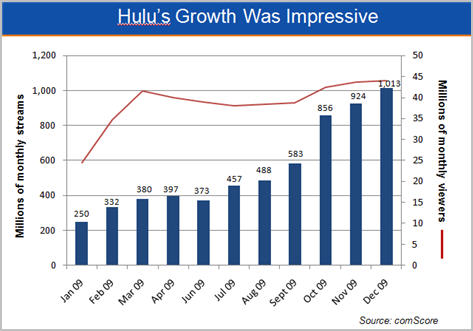
A few months ago I speculated that Hulu's relatively flat pattern in uniques could suggest that, in its current configuration, Hulu may have saturated the market for its content and user experience (for example, contrast Hulu with YouTube, which grew its uniques by 33% in '09 to 135.8 million by Dec '09). I'll be looking to see if Hulu can notch more noteworthy increases in uniques during '10; if not, then I think my thesis will be proven correct.
Nonetheless, Hulu's viewers clearly love the site, with average number of videos per viewer more than doubling to 22.9 in Dec '09, up from 9.8 in Dec '08. Users are spending more time on Hulu, increasing the amount of total minutes on the site from 58 in Mar '09 to 132 in Dec '09. What's remarkable though is that the average minutes watched per video (the yellow line below), has stayed virtually constant at around 6 minutes each month. That shows that while there's plenty of long-form consumption happening at Hulu, clips are still very popular too.
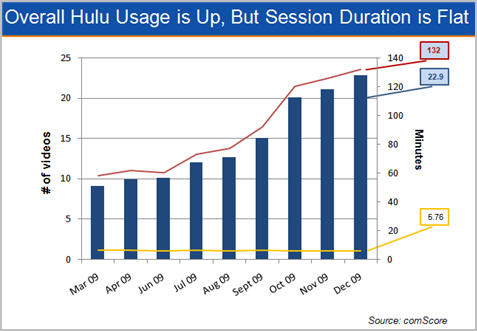
comScore is a great source of month in and month out online video data, but as always my caveat is that no third party can ever track usage as closely as the sites themselves, so take these numbers with a small grain of salt!
Click here if you'd like a complimentary PDF download of all of the slides.
What do you think? Post a comment now (no sign-in required).
Categories: Aggregators
Topics: comScore, Hulu, YouTube
-
From an Online Video Perspective, Super Bowl Ads Are a Mixed Bag
The great Super Bowl game last night was once again not matched by the quality of the ads, at least when viewed for how well they leveraged online video. For several years now, I've been arguing that the $2.5-3 million that advertisers spend on their 30 second Super Bowl spots could yield a far higher ROI if they figured out how to extend their experiences through online video. So once again this year I've reviewed all of the Super Bowl ads - not for how funny, creative or gross they were - but for how well they took advantage of the benefits online video offers.
First, some basic stats: of the 58 ads that ran during the game last night (which I viewed this morning at CBSSports.com), 38 of them were tagged with a URL and 20 were not. On a percentage basis that's about equal to last year, when 37 of the 56 ads carried a URL. Of the 38 ads with a URL, only 4 of them explicitly urged the viewer to see more or watch more at their web sites:
-
Focus On the Family - The controversial Tim Tebow advocacy ad invites viewers to visit the Focus web site to see the full Tebow story. The site has a long interview with Tebow's parents along with lots of other video. Regardless of your politics, the ad works well as a friendly teaser for viewers to learn more about the organization.
-
Boost Mobile - Jim McMahon and the hilarious rapping NFL players take it to a new level by actually ending their rap with the line "Go online to find the rest of our jam," then exposing the URL. Further videos at the site continue the fun.
-
GoDaddy - The web site hosting company was back with its ads featuring Danica Patrick and teasing viewers to "See more now at GoDaddy.com." The scantily-clad GoDaddy girls concept is a little stale now, but for the male-dominated game audience, there's no doubting its appeal.
- HomeAway.com - My personal favorite, this vacation home rental company bought back Chevy Chase and Beverly D'Angelo as The Griswolds for "Hotel Hell," a spoof of the famous "Vacation" movie series. The ad is totally focused on getting viewers to see the film at HomeAway.com. Chase is a classic and the videos are very clever.
Outside of these four, a handful of others are on my honorable mention list. From a user involvement standpoint, CareerBuilder's provocative ad with workers walking around in their underwear (which was the result of its "Hire My TV Ad" contest) was a winner and built on the success Doritos has had with its own $1 million user-generated contest. Monster.com has an interesting engagement opportunity at its site, allowing users to create their own "Fiddle a Friend" music videos with their violin-playing beaver. Speaking of animals, you had to love Bridgestone Tires' "Whale of a Tale" ad featuring 3 guys trying to drive a whale back to the ocean - Bridgestone makes behind the scenes clips here.For more behind the scenes, Dove's new Men Care line features an interview with MVP Drew Brees, who's also shown lathering up in the shower (a blatant pitch to women as well as men). E-Trade was back with its talking babies, but this year with a twist, allowing site visitors to send their own "Baby Mail" emails. The new Honda Accord Crosstour features a well-produced video of the car, though no mention of the video is made in its game ad. And how about the futuristic Vizio ad trumpeting its Internet-connected TVs? It's surely a sign of many more connected device ads to come in future years.
Lastly, a few real misses. First up, what's the deal with Budweiser? It ran 9 ads and not one of them carried a URL. These folks are mistaken in thinking that viewers wouldn't be interested in more about the Clydesdales on the web. Beyond the horses, it would have been cool to learn more about how Bud made the human bridge ad, or did the voice effects in the T-Pain spot. Ditto for Denny's which was promoting its Grand Slam breakfast hard, but didn't do any web tie-ins. The movie ads make me nuts too. They roll the credits so fast at the end of the ad and the text is so small that it's nearly impossible to find a URL to learn more about the movie, even if you wanted to.
The Super Bowl is the biggest event on the sports and advertising calendars, yet as evidenced by this year's performance, most brands and agency creative types still don't fully understand the power of online video. Sure, the post-game galleries drive millions of additional views, but I continue to contend they could be so much more. Oh well, onto Super Bowl XLV.
What do you think? Post a comment now (no sign-in required).
Categories: Advertising, Sports
Topics: Boost Mobile, Focus on the Family, GoDaddy, HomeAway.com, Super Bowl
-
-
Watching Hulu Content on Facebook Through ClipBlast's App is Cool
Here's something cool: ClipBlast updated its Facebook app yesterday to now include access to practically all of Hulu's content. ClipBlast's CEO/founder Gary Baker walked me through a demo and I was quite impressed. Once you've added the app, you can favorite certain Hulu shows and they appear as tiles which you can then easily scroll through. It's a huge step forward from Hulu's own mediocre Facebook app. You can also choose video from over 8,500 other sources that ClipBlast offers.
Though I'm personally not a huge Facebook user, the app resonated with me because it makes discovering and sharing video even more powerful as Facebook friends are just a click away. Of course Hulu has offered embedding from the start, but to get almost the whole Hulu library into Facebook, in front of a potential audience of 400 million users is classic "syndicated video economy" thinking. In the SVE, instead of solely trying to bring audience to your content (the traditional media model), efforts are also focused on bringing your content to the audience, wherever they live. All of Hulu's ads flow through as well, so views are still fully monetized. What's missing is full screen viewing, which Gary said is coming shortly.
What do you think? Post a comment now (no sign-in required).
Categories: Aggregators, Syndicated Video Economy, Video Sharing
Topics: ClipBlast, Facebook, Hulu
-
Replay of Yesterday's Net Neutrality Webinar is Now Available
Yesterday VideoNuze and The Diffusion Group hosted "Demystifying Net Neutrality," the first in our 2010 webinar series. Our guests, Barbara Esbin, Senior Fellow and Director, Center for Communications and Competition Policy, Progress & Freedom Foundation (against) and Chris Riley, Policy Counsel for Free Press (for) did an outstanding job advocating their positions. Net neutrality is extremely complex and we had a flood of questions, which our guests did a great job of addressing.
Though Chris made his points well, personally I'm still not persuaded that net neutrality regulations are needed now. As I wrote last fall, my core concern is that no sustained pattern of broadband ISP behavior has been proven. Colin and Chris argue that "corporations can't be trusted" and that inevitable biases will arise for the biggest broadband ISPs who are also the biggest video service providers. All of that may be true. But until it's proven, it's dangerous business to start tinkering with the well-functioning Internet. The FCC should stay vigilant, but not pursue net neutrality regulation now.
What do you think? Post a comment now (no sign-in required).
Categories: 4 Items, Broadband ISPs, Regulation, Webinars
Topics: FCC, Net Neutrality, Webinar
-
Will This Year's Super Bowl Ads Finally Leverage Online Video?
It's Super Bowl time again, which means it's time for me to write my annual post wondering whether this will
 be the year that Super Bowl advertisers really embrace online video and social networking opportunities. Four years ago, I speculated that at some point a Super Bowl ad could go for $10 million apiece, because the online video extensions could drive the ROI so much higher than what a traditional 30 second ad alone delivers. Nonetheless, advertisers and their agencies have been painfully slow to get with the online video program, and I've been ranting about the missed opportunities (see here and here) year after year.
be the year that Super Bowl advertisers really embrace online video and social networking opportunities. Four years ago, I speculated that at some point a Super Bowl ad could go for $10 million apiece, because the online video extensions could drive the ROI so much higher than what a traditional 30 second ad alone delivers. Nonetheless, advertisers and their agencies have been painfully slow to get with the online video program, and I've been ranting about the missed opportunities (see here and here) year after year.As this NY Times piece describes though, this could finally be a breakthrough year. I like the way that Kathy O'Brien, VP for personal care at Unilever put it, "The Super Bowl is an element of a complete, 360-degree campaign." That's smart thinking. On Monday I'll tally up the score to see how this year's Super Bowl advertisers did with their online video and social networking extensions.
What do you think? Post a comment now (no sign-in required).
Categories: Advertising, Sports
Topics: Super Bowl
-
YouTube's Meager Sundance Rental Revenues Really Weren't That Surprising
This week brought news that YouTube's recent foray into rentals netted the company a whopping $10,709.16. I wasn't surprised by the results, as YouTube only made 5 Sundance films available for 10 days. As I suggested 2 weeks ago, even with YouTube's massive audience, it would be unreasonable to expect too
 much. Still, it was great promotion for the indie film producers and no doubt a learning experience for YouTube.
much. Still, it was great promotion for the indie film producers and no doubt a learning experience for YouTube. I'm not religiously opposed to YouTube broadening its model beyond free and ad-supported video, but I do think YouTube needs to be wary of spending a lot of time trying to secure me-too rights for distribution of Hollywood's prime TV and movie output. That's highly competitive ground, and Netflix for one, has enormous advantages given its robust subscription model. YouTube is in the pole position when it comes to the ad-supported online video model and it needs to be relentlessly focused on proving it can make the model profitable.
What do you think? Post a comment now (no sign-in required).
Categories: Aggregators, FIlms, Indie Video
Topics: Sundance Film Festival, YouTube
-
VideoNuze Report Podcast #48 - February 5, 2010
Daisy Whitney and I are pleased to present the 48th edition of the VideoNuze Report podcast, for February 5, 2010.
This week we get started with me reviewing yesterday's post about FreeWheel now serving close to 2 billion video ads per month and signing up MLB Advanced Media as their newest customer. FreeWheel's Doug Knopper told me that it is benefitting from both its new customers and also from year-over-year increases in ads served for existing customers. FreeWheel is also in the middle of the "syndicated video economy" that I've written before, having integrated with big third parties such as YouTube, AOL, MSN, Fancast and others.
Then Daisy describes her interview from last week's NATPE show with Chloe Sladden, director of media partnership for Twitter. The company is planning to launch its Media Developer's Platform later this year, along with new measurement tools. Daisy shares what she learned.
Click here to listen to the podcast (12 minutes, 38 seconds)
Click here for previous podcasts
The VideoNuze Report is available in iTunes...subscribe today!
Categories: Advertising, Podcasts, Technology
Topics: FreeWheel, MLB, Podcast, Turner, Twitter, VEVO
-
Exclusive: FreeWheel Serving Almost 2 Billion Video Ads/Mo, MLB is Newest Customer
FreeWheel is on a roll, now serving almost 2 billion video ads/month, doubling its volume just since November, 2009. In addition, the company has added Major League Baseball Advanced Media to its customer roster and began implementing ads during the fall playoff season. The MLB win comes on top of recently announced customers Turner Broadcasting System and VEVO. FreeWheel's co-CEO/co-founder Doug Knopper brought me up to speed on all the news late last week.
Doug said that part of the increase in FreeWheel's volume is attributable to the additional customers that have come on board, but he's also very excited about the year-over-year growth in ad volume FreeWheel is
 seeing for longer-term customers ("same store sales" if you will). FreeWheel is seeing big increases due to 3 factors: customers posting greater quantities of video, plus deepening viewership of that video (all of this borne out by comScore's '09 video consumption data); customers' improving ability to actually sell ads against these videos (reflecting the shift of budgets to the online video medium); and reduced friction through the emergence of "accepted practices" in ad operations.
seeing for longer-term customers ("same store sales" if you will). FreeWheel is seeing big increases due to 3 factors: customers posting greater quantities of video, plus deepening viewership of that video (all of this borne out by comScore's '09 video consumption data); customers' improving ability to actually sell ads against these videos (reflecting the shift of budgets to the online video medium); and reduced friction through the emergence of "accepted practices" in ad operations. FreeWheel is also benefiting from its specialization in helping content providers monetize their video on third-party sites (e.g. YouTube, AOL, MSN, Fancast, etc.). More and more content executives are realizing that sizable viewership opportunities exist by syndicating their video outside of their own properties. Doug said that every content company FreeWheel is now talking to is interested in some kind of syndication.
Doug described 3 types of syndication he's seeing: (1) across a family of sister corporate sites, such as PGA.com providing CNN.com video, which are both owned by Turner; (2) between affiliated entities like local MLB teams providing video to the main MLB.com hub and (3) externally, to unaffiliated 3rd parties, such as WMG music providing videos to YouTube. Given all this syndication activity, I was interested to learn from Doug what percentage of the ads FreeWheel serves fall into each of these 3 buckets vs. what percentage are served on the customer's sites themselves. Doug said that FreeWheel is pulling those numbers together in a way that ensures its customers privacy and will get back to me when he has them.
In addition to the above syndication activity, FreeWheel is seeing experimentation with delivering ads to mobile devices, convergence/CE players and Internet-enabled TVs. In all these cases, customized ad policies determine who sells what ad inventory and how revenue is shared and reported. Powering all of this has been part of FreeWheel's core mission from inception, making it a key player in what I've called the 'syndicated video economy."
FreeWheel's growth echoes what I've been hearing lately from both video ad network executives and video content providers. They too are talking about rapidly rising volumes and improving monetization. As I wrote recently, I've been impressed lately by efforts to make video ads more engaging and provide a better ROI, a trend I see continuing. Taken together, while it's still relatively early days, online video advertising seems to be making great strides.
What do you think? Post a comment now (no sign-in required)
Categories: Advertising, Sports
Topics: FreeWheel, MLB, Turner, VEVO


